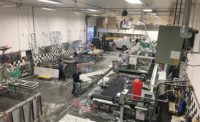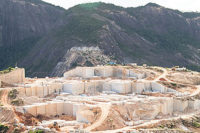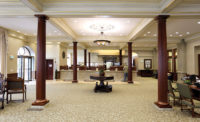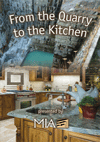“The overall goal was to create zero-maintenance, no-nonsense, timeless landscape elements in the form of water bodies and planters,” said Ruchika Grover, director of Odyssey: Stone Architecture & Design. “Stone was selected as a material for its timelessness, versatility and hardiness.” Specifically, Grover focused on granite in several varieties, including Steel Gray, Sapphire Brown, Tan Brown, Raw Silk Ivory and Lavender Blue. The stones, supplied by Pearl Mineral Pvt. Ltd. of New Delhi, were chosen for their color, consistency and level of water absorption. The material was procured directly from quarries in South India in the form of blocks and then processed in 30/80/100/150 mm thicknesses.
|
Terminal 3 Indira Gandhi International Airport New Delhi, India |
|
Architect: Odyssey:Stone Architecture & Design Stone Supplier: Pearl Mineral Pvt. Ltd., New Delhi, India |
The granite chosen also added texture to the space. For the project, the team did not want to use stones similar to the original space for fear that they would blend in. “We wanted the features that were developed to be focal pieces, which stand out,” said Grover. “At the same time, we have used softer, smoother lines, which blended well within the built context of the space. This way, we have achieved a balance in making the stones stand out, but the features look like they belong.”
The external water features, consisting of 150 tons of Steel Gray granite, include five water bodies at the rotaries along the landscaped areas of the terminal. The step fountains are made of 80-, 100- and 150-mm-thick, pre-cut, polished, grooved and tapered solid pieces of granite, which were processed at a plant in Ongole, India. Each stone piece was numbered to ensure a smooth assembly and installation process on site. The stone finish is a combination of high gloss and honed. For the planters, which are made of slabs with a thickness of 30 mm, the granite was given either a leather or high-gloss finish.
The water cascade at the arrival lounge is the only internal water feature, made with a combination of Raw Silk Ivory, Lavender Blue and Steel Gray granite. The pieces were grooved and cut using a combination of CNC and waterjet machines.
The biggest challenge the team faced was controlling the variation, as the quantities involved were very large. The timelines were also an issue. The timeframe for completion was anticipated by Odyssey to be six months; however, they were required to be finished in half that time. Another challenge was the coordination for deliveries of the planters. “We were provided a space off-site by GMR to assemble the planters, and they had to be delivered upon the completion of the areas where they were to be placed,” said Grover. “Even after delivery, the planters had to be moved around a lot within the terminal for the other agencies to complete their respective jobs. This resulted in damages and breakages to the completed planters.”
The reaction to the project has been very encouraging and positive. Both the water features and the planters have been built to be maintenance free. Additionally, the planters have been designed to accommodate both small and large planters due to the slotted framework. “They are very functional and aesthetically appealing at the same time,” said Grover. “Each of these planters was tested by ramming baggage trollies with 30 to 40 kilogram weight to check their resistance to impact.”











